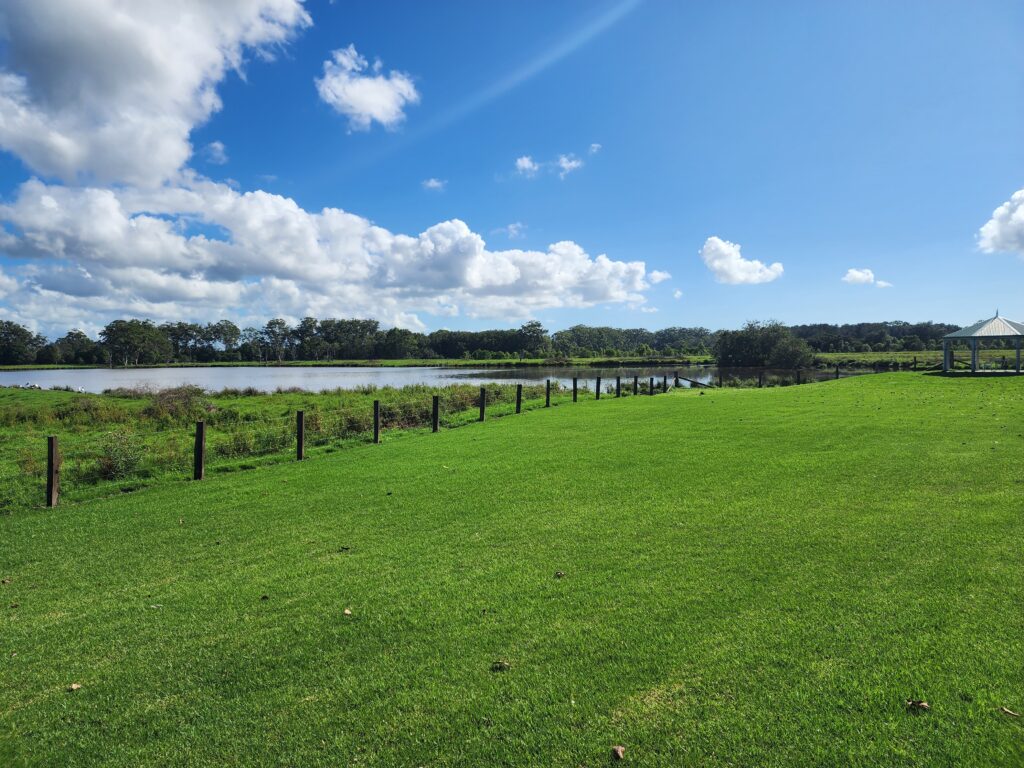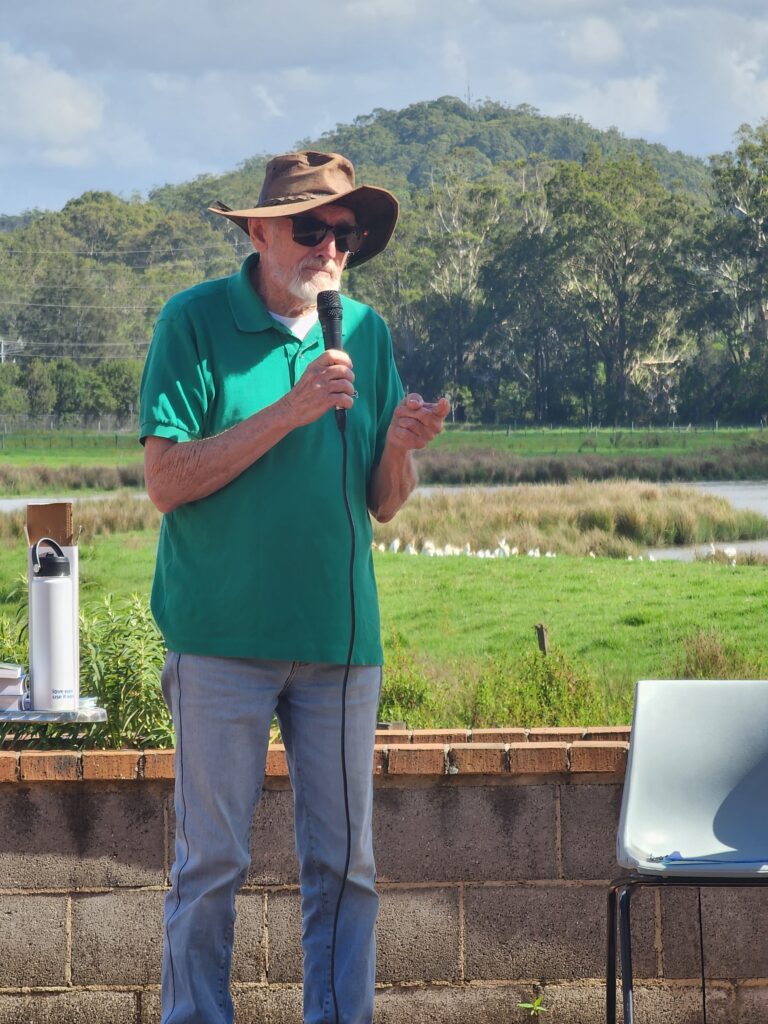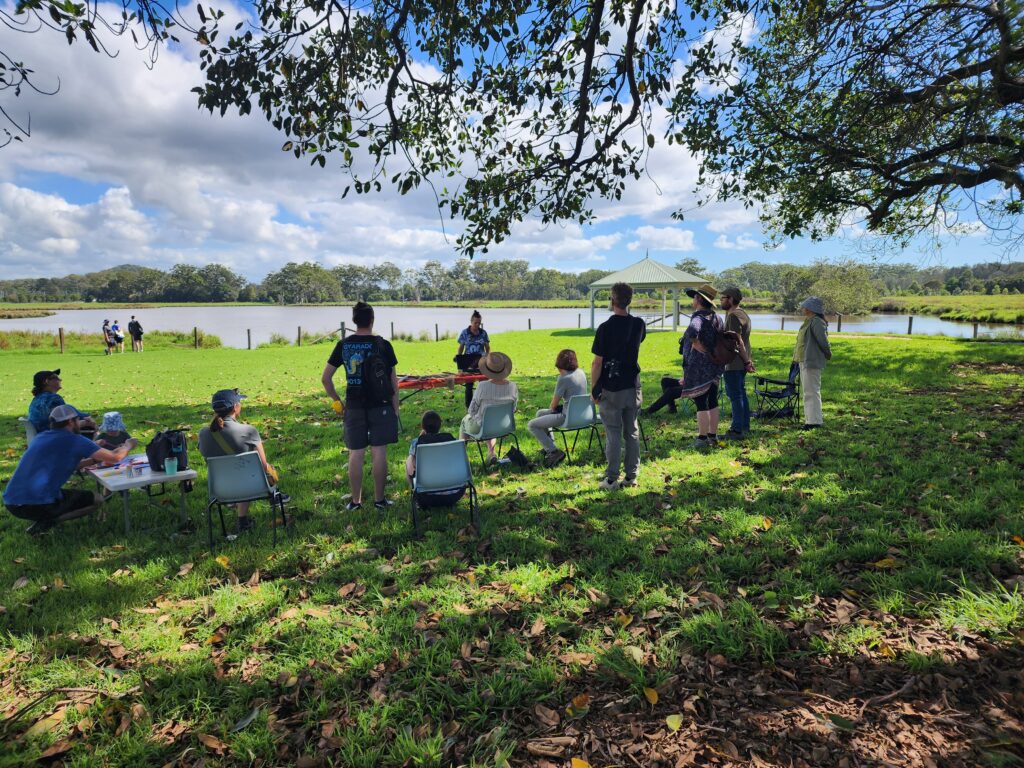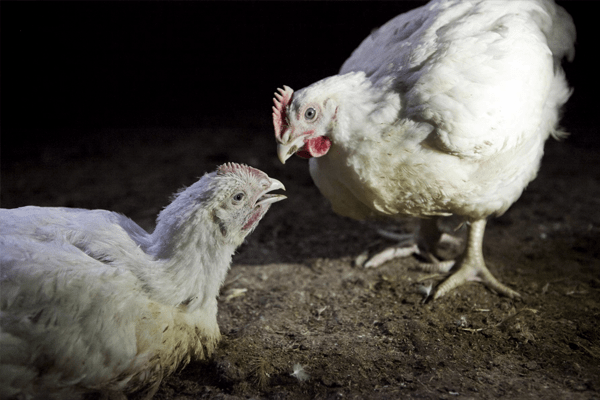Some communities, and politicians, have had the foresight to save and protect wetlands – the Central Coast Wetland on the site of the former Pioneer Dairy, south of the Wyong River, is one such fairy tale come true.

By Jacquelene Pearson
The Central Coast Wetland, on the site of the old Pioneer Dairy, just south of the Wyong River, is an excellent example of how a wetland can be saved and protected for the benefit of both the environment and the community.
Long-term Jilliby resident and environmental campaigner, Mike Campbell OAM, was part of a campaign in the 1980s to save the wetland when the NSW Government of the day wanted to turn it over to coal mining and electricity generation.
From the beginning
Even earlier, back in the mid-1970s, the state government wanted a power station built at Chittaway Bay, on the shore of Tuggerah Lake but, according to Mike Campbell, there was a community campaign that fought it off.
The area under threat in the 1970s became the Tuggerah Lakes Nature Reserve under the care of the National Parks and Wildlife Service. A Nature Reserve gives even more protection to the area than a National Park.
But in the 1970s, and again in the 1980s, the proposal involved mining for coal under the lakes and filling that enormous wetland with coal dumps and power station ash dams.
“In 1982-83 they really had plans to develop a Mardi power station and they definitely wanted Wyong and Tuggerah to be swallowed up completely in power stations and coal mines,” Mr Campbell said.
Stopping coal 80s style
“They really wanted the coal that was under the lake and under the catchment area and that was the goal, and they were pushing ahead. The Electricity Commission was planning this expansion.”
In terms of what the Electricity Commission was proposing for the Pioneer Dairy site, according to Mike Campbell, “They had earmarked it for a substation but that was only for public view.
“The Pioneer Dairy was a vast dairy, nearly 400 hectares, and there were to be two collieries there and others around Wyong and coal dumps and a mine shaft and access facilities for going under the lake.”
The area that was going to be the mine entrance, base facilities and worker car park, has since been turned into the Central Coast Regional Sporting Complex at the Tuggerah end of the old dairy.
“They planned a large conveyor carrying the coal across the Wyong industrial estate, the highway and the railway, across to the proposed Mardi power station which was to be located right next to the Mardi dam – the dam for our drinking water.
“When you have a power station you must have an ash dam nearby. So literally, Wyong River, from where the old Milk Factory is, all the way back to near Mardi Dam would have been ash dam. They had no concern at all for the environment or human health.”
The community was able to trigger a commission of inquiry into electricity planning in NSW as part of their campaign to stop the plans for the Wyong and Tuggerah areas.
“We did a lot of work around the progress associations. I remember talking to the Lake Munmorah community. They said the asthma and bronchitis up there from the power stations, and the air quality, was terrible. That was from Vales Point, Munmorah and Eraring power stations.
“I happened to talk to the University of Newcastle air quality specialist, and he said ‘well here is a document, we did a document a couple of years ago, three professors and it is there so you can have a copy of it,’ so I brought it home.
“When I opened it up of course Doyalson was critical, they literally said the Sulphur dioxide emissions from the power station were at a critical level and Doyalson was absolutely off the map.
“The professors said there should be no more Sulphur dioxide emitting industries located in the area. Of course, I thought, ‘hang on, bang oh!’ The Munmorah people had been complaining about it. What have we got here? This was only about two weeks before the Commission was having a hearing in Gosford.
“So I got on to the progress association at Munmorah and they said, ‘yes the doctors have been complaining about it too’.

“I picked up the telephone, called the doctor, got on to the doctor, which is unusual. He said, ‘Yes I have heard about those new plans down south’. I said, ‘would you put your concerns about air quality on paper?’ and he said, ‘I most certainly would’, so there it was on paper.
Cause and effect
“What we had from the University of Newcastle was a causal study and now we had an effect from the doctor at Munmorah. “The statement from the Munmorah doctor stopped the hearing at Gosford because this was something from left field.
“It was in the Gosford Council Chamber. The Electricity Commission was there. All the media was there. Tony Spears (another campaigner) was standing there giving our submission.
“I came in and handed him the doctor’s statement and he said, ‘I want to divert from what I have been saying to tell you about what is going on in the north. The air quality. The asthma and bronchitis, here is the doctor’s statement, here are the studies’.
“The independent commissioner read the document briefly and said, ‘I am suspending the commission, and you will hear from me when I am reforming the commission’.
“The Electricity Commission were stunned.
“There were other groups involved, people from the valleys and other media. The hearing was in August and the next thing in October it hit the headlines on every major newspaper in Australia – about the fallout from the power stations.
“There was a story about the asthma and bronchitis, with a big photo, on the front of the Sydney Morning Herald. The live shows, all the talkback shows, were up there at Munmorah with their cameras interviewing people.”
At the time of the inquiry the Electricity Commission of NSW was a powerful body.
“They were the dealer around the table,” Mike Campbell explained. “They held all the cards in terms of what happened in portfolios … and really, what happened was this inquiry was well founded.”
The inquiry revealed that the Electricity Commission had been borrowing heavily overseas and so the government of the day was able to say, ‘we can’t keep borrowing money overseas to build these massive power stations’.
“This Commission, what happened with our intervention, was it gave the Labor Government of the day the tools to begin to dismantle this power base. They had been wanting to do it but they needed the tools to do it.
“They weren’t going to get their three and a half more power stations because of what we uncovered here. It really gave the government of the day the power to intervene.
“This campaign here stopped the progress of building coal fired power stations. They built another part of Mount Piper but from then on, no more power stations were built in NSW.”
Saving the land
Of course, the campaign didn’t end there. The Electricity Commission decided it wanted to sell the Pioneer Dairy land, which it had acquired from the Hammond family.
“The land became surplus for the government. It was sitting there so they said they could sell it off. It went on the market as a 400-hectare dairy so what could be done?”
Former Wyong Shire Councillor and Mayor, Bob Graham, went to the relevant state minister and asked for the land to remain a community asset, potentially a golf course.
“We lobbied the environment minister then and eventually, with a lot of heavy lobbying, the minister had it pulled off the market.”
A few years later it was back on the market.
“The Labor councillors in Wyong pulled in Grant McBride, then Member for The Entrance, and Paul Crittenden, the Member for Wyong, to support the campaign.
“It was a political football. In 1997 the Chamber of Commerce got involved and then there was a Native Title claim established so the government again pulled it back off the market.”
In 2002 the site was finally declared open space for the environment and education and it was given back to the people.
“There was a lot of politics going on in the background. Paul Crittenden played a critical role and Grant McBride, and they got it gazetted as a public reserve and volunteer trust and I was appointed the first chairman of that trust.”
Polishing the gem
“It is beautiful. You drive under the railway and there it is in front of you. You’ve got the river on the left-hand side and then you’ve got this vista. The lagoon in the middle and the forests,” Mike Campbell said, when asked to describe the Central Coast Wetland as it is today.
But it took a lot of volunteer hours by many in the community to restore it to the state it is in today and the work is ongoing.
“We had to spend a lot of time and money dismantling buildings and just making it safe. All the fencing had to be done, and we had to clear 40-50 years of wire and posts.
“We had our fantastic guy Don Craig who came on the trust. Don was magnificent. He was a driver. I got swept up with Don. He used to work in the Forestry, so he had knowledge about propagation, he had golden or green fingers. Neil Bevege is another one who is still around and John Salmon.”
Under Don Craig’s leadership over 100,000 trees were planted along the main creek passing through the property.
Over the years the membership of the Land Manager or trust committee looking after the site has changed and evolved.
“Marleen Penning and her committee restored the main building and did a good job of getting another building up. Now we have a new, young vibrant trust,” Mr Campbell said.
“It does take a lot to look after a wetland. The young people have studied plants and know how to work on the wetlands.”
Premiere bird watching
Deputy Chairperson of the current Land Manager for the Central Coast Wetlands and Pioneer Dairy site, Allan Benson, is a committed bird watcher. He described Central Coast Wetland as one of the premiere bird watching spots in the region.
“Myself and another birder wanted to go on the Land Manager committee to ensure it is preserved for that purpose. I have been watching birds there for 25 years,” Benson said.
According to Mike Campbell, earlier generations of dedicated local birders, including John and Carol Carpenter, would literally camp on site in their campervan and, over the years recorded 190 species.
“And that was before we even had the trust drawn up, so the birders were already in there when it was really just a quasi-small farm area,” Campbell said.
According to Allan Benson, the wetland offers a range of habitats that attract water birds and land birds.
“It also acts as a little bit of a net for migratory birds or vagrant birds. It is so popular with birders because a lot of rare birds turn up there and it does attract non-local bird watchers,” Mr Benson said.
“In fact we have just done a survey, via a lot of facebook groups, that confirms it is well known and it does attract people from outside of the Central Coast.”
Migratory birds that visit the site annually include the Latham Snipe from Japan, the Wood Sandpiper that migrates from Siberia along with the Sharp Tailed Sandpiper that also makes the trip from Siberia.
“We have had some rare waders – including Long Tailed Stint and Oriental Plover. They are the ones that have been seen.
“We have spring migrants who come down from further north to breed including the Channel Billed Cuckoos who like to feed on the figs.
“White Winged Triller and the Brown Songlark are two other species that have been spotted that both come in from the west but are only seen occasionally.”

Money matters
Mr Benson said he believes the site is safe for future generations.
“The whole area is flood prone, so it is not suitable for development full stop: 90% of our useable land is flood prone.”
The site also operates in a way that is becoming financially self-sufficient, so it is not an impost to the public purse.
“If you look at how the dairy is made up, about half of it is put over to grazing, a third is for natural bushland including bird watching and the balance is for recreation. It is a good balance. The grazing is important because it is an income, and the grazing keeps the grass down.”
Agistment is outsourced and 100 head of cattle are cared for on the site.
That’s not to say the wetland and recreational land do not take significant costs for upkeep.
“Sources of income are the golf range, agistment and rental of the cottage and minor licensing fees. We would like to rent out the pavilion more.
“We only have one access road in and out, so the council won’t let us conduct night time activities. We are about to put another road in coming off Bryant Avenue. We think we can make the site work for nighttime events and weddings once that second entrance is built and open.”
One of the major ongoing conservation projects at the site is the restoration of a major riparian corridor. To date, 200,000 trees and shrubs have been planted along Tuggerah Creek and the Green Fleet paddock.
According to Mr Benson, a substantial area has been replanted including Swamp Mahogany, a winter flowering species that attracts the critically endangered Swift Parrots and Reagent Honey Eaters.
“Half of the area along Pioneer Creek out towards the road, has been revegetated and it has done extensively well, and we have a grant from Local Land Services to expand right to the road.”
Bright future
Members of the current Land Management committee at Central Coast Wetland, including Allan Benson, are keen to tell the world about the site.
“We would like to encourage more usage. We are keen to publicise it. We have just spent more than $500,000 on replacing the potholed road.
“We are seeing more recreational use. We are seeing disability groups take advantage of the picnic areas.
“The Park Run is about to start from 5 April – and that will attract 50 to 100 people each week and that is good from our point of view and from the participants who enjoy running through nice habitats and scenic areas.
Major functions, requiring exclusive use of the facilities, need to be booked but the picnic tables and toilets are open to all.
“The gazebo that overlooks the wetland is a great place to relax and go bird watching. The gazebo acts as an excellent bird watching place. When we put the second phase of the track along Pioneer Creek, we will put another bird watching spot similar to what we have got.”
Mr Benson said he has two preferred bird watching spots at the Central Coast Wetland: “one is the gazebo because it gives you a view of the ducks and waterfowl and the other is coming along the entrance road where the wetland comes close to the road.
“The other nice thing from a birding point of view is it attracts a lot of raptors because it is a feeding source for them: Whistling Kite, Black Shouldered Kite, Swamp Harrier, Sea Eagles, Hobbies and Peregrine Falcon, they are all there from time to time.
“Whistling Kite nests in the trees near Pioneer Creek, and we think the Black Shouldered Kites also nest nearby because there was a juvenile seen.”
The current committee thinks between 50 and 100 cars access the site daily including those using the golf driving range and other groups who use the site including the SWAMP community garden group, a propagation nursery and play groups.
Local to global
According to Mike Campbell, the Central Coast Wetland Pioneer Dairy site is a treasure for future generations and can be a place of learning as well as conservation.
Some of that learning has to be about the threats and the interactions, he said.
Mr Campbell said the main threats included “pushing down more bushland, filling around the edges of wetlands…
“We have got to try and re-establish the thinking of the 1990s when we had good councils and people who had a lot of input into preserving natural areas. Council listened. They would sit up there, and they would listen.
“Unfortunately there are a lot of pro developer people on council now and they get their avenues into government and government and property developers or business people but they don’t voice environment.
“I can’t understand why. They must have children, grandchildren, what are they leaving?
“It is all a web, a whole thing, things are interconnected, forests, wetlands, waterflows, lakes. You can’t just pull one thing out. It is a web of things. We live in the environment.
“People don’t understand the basics of climate change. We are talking about parts per million of carbon in the atmosphere: we are up to 472 ppm in the atmosphere. It has never been seen before.
“I think in the dinosaurs’ age we got up to 360 parts per million of carbon in the atmosphere and that is measured, all around the world by all the different scientific bodies. The same amount of carbon is in the atmosphere in New York as it is in Tasmania. It doesn’t matter.
“The amount of carbon in the atmosphere is on a j-cruve and, with climate change, the objective is to bend the j-curve. Well, we are not bending the j-curve which comes down to these local things – the preservation of forests, the preservation of wetlands.
“Wetlands and forests keep temperatures down; temperatures are lower in those regions. You begin to fill wetlands and knock down forests, and all the sudden in those regions you will find the temperature rises.
“It is a worldwide project.”


